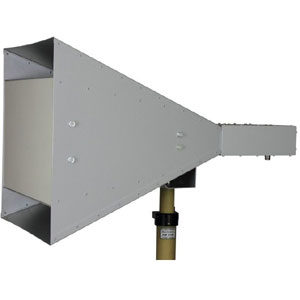Biconical Antennas have dipole like characteristics (e.g. circular directional pattern in the H-plane,”8″-shaped in the E-plane, fixed phase center, comparable gain), with an enormous wide bandwidth achieved by the double cone elements. One of the earliest and worldwide most popular biconical antenna designs is the BBA 9106 with balun VHA 9103 B. During the last years a growing need for expanded frequency ranges arised, which led to the design of biconical antennas reaching down to frequencies of 20 MHz and up to 18 GHz and above. A further increase of bandwidth was achieved with qualified 4:1 baluns, providing a typical gain increase of approx. 6 dB at the lower frequency range. The biconical elements can be mounted and dismounted within a few seconds providing perfect contact repeatability thanks to special clamping fixtures. A small wrench made of insulating material is supplied with the balun, it is tied to the balun head and thus always available whenever needed. Biconical antennas can be used for many applications, in which half-wave dipoles have been used traditionally. An enormous reduction of measurement time can be achieved, because the time consuming tuning of the antenna elements to the half wavelength is not needed, an important condition for sweeped broadband measurements. In typical dipole applications several discrete frequencies are measured, in contrast the biconical antenna allows continuous sweeps, where site anomalies are discovered much easier.
Typical applications for biconical antennas are:
- Broadband RX-antenna for emission testing (20-300 MHz)
- TX-antenna for immunity testing, especially at low frequencies
- Measurements of shielding effectiveness
- Evaluation of test sites e.g. anechoic rooms (FAC) and open area test sites (OATS)
- Passive field probe for immunity testing



